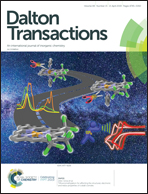Coordination-induced metal-to-macrocycle charge transfer and effect of cations on reorientation of the CN ligand in the {SnL2Mac}2− dianions (L = CN−, OCN−, Im−; Mac = phthalo- or naphthalocyanine)†
Abstract
A series of anionic coordination complexes of tin(II) phthalocyanine (Pc) with cyanide, cyanate, and imidazolate (Im) anions (1, 3, and 4, respectively) and tin(II) naphthalocyanine (Nc) with cyanide anions (2) has been obtained. Two anions coordinate to tin(II) atoms in 1–4 to form the {SnL2Mac}2− dianions in salts with the general formula {crypt[2.2.2](M+)}2{SnL2Mac}2− (M = K or Na; Mac: Pc or Nc; L = CN−, OCN−, Im−). The coordination of two ligands to SnII stabilizes these atoms in the higher tin(IV) oxidation state, providing transfer of two electrons from SnII to the macrocycle. The formation of tetraanionic (4−) macrocycles is accompanied by the appearance of new absorption bands in the NIR range, essentially blue-shifting both Soret and Q bands, and noticeable distortion in the macrocycles in 2–4, showing alternation of the C–C and C–N bonds. However, such distortions are not observed in 1. The absence of alternation in the case of 1 can be explained by the effect of uncompensated electric field from the surrounding cations, which stabilizes the macrocycle configuration with aligned bonds but nonuniform negative charge distribution on the imine nitrogen atoms. The cyanide ligand coordinates to SnPc by a nitrogen atom in 1, forming a Sn–N bond of 2.339(1) Å in length, whereas the cyanide ligand coordinates to SnNc by a carbon atom in 2, forming a shorter Sn–C bond of 2.266(3) Å in length. DFT calculations support the reorientation of the CN ligand in 1, which is induced by the electrostatic field of closely located cations.



 Please wait while we load your content...
Please wait while we load your content...